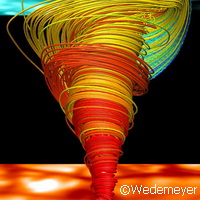Space tornadoes may hold key to solar mystery
A team of European scientists has discovered super-hot and super-fast tornados on the Sun, which may help answer a number of outstanding questions in the realm of physics. Writing in the journal Nature, they report that these `magnetic¿ tornadoes reach speeds of up to 10,000 kilometres per hour, completely dwarfing anything found on Earth. In fact the fastest recorded tornado on Earth only reached speeds of approximately 486 km per hour, and was by no means an example of a common occurrence. These magnetic tornadoes on the Sun, created by rotating magnetic field structures which force plasma to move in spirals, are not only common but may hold the answer to a long-standing physics conundrum: why the surface of the Sun is cooler than its outermost atmospheric layer. Think of any fire and it is common knowledge (and sense) that the closer one gets to the fire, the hotter it gets. The Sun however doesn't quite follow this logic. Its central core is an amazing 15,000,000 degrees Celsius and its surface cools to 5,500 degrees Celsius - following the logic that the further away, the cooler it gets. The Sun cools to a mere 4,300 degrees Celsius to where a layer of the Sun's atmosphere, the photosphere, meets the chromosphere. In the chromosphere, however, things become topsy-turvy. When the chromosphere begins to merge with the Sun's outermost atmospheric layer, the corona, the temperature rises to 100,000 degrees Celsius and continues to increase to a scorching 2,000,000 degrees Celsius in the part of the corona that is farthest from the Sun. This, almost accordion-like sequence of heat, has puzzled many scientists. A puzzle which this recent discovery of magnetic tornadoes may have solved. Professor Robertus Erdélyi, head of the Solar Physics and Space Plasma Research Centre (SP2RC) of the University of Sheffield's School of Mathematics and Statistics explains: 'One of the major problems in modern astrophysics is why the atmosphere of a star, like our own Sun, is considerably hotter than its surface? Imagine, that you climb a mountain, e.g. a munro in the Scottish highlands, and it becomes hotter as you go higher and higher. 'It is understood that the energy originates from below the Sun's surface, but how this massive amount of energy travels up to the solar atmosphere surrounding it is a mystery. We believe we have found evidence in the form of rotating magnetic structures - solar tornadoes - that channel the necessary energy in the form of magnetic waves to heat the magnetised solar plasma. 'We report here the discovery of ubiquitous magnetic solar tornadoes and their signature in the hottest areas of the Sun's atmosphere where the temperature is a few millions of degree kelvin, about thousands of kilometres from the Sun's surface. This is a major step in the field.' It is estimated that there are as many as 11,000 of these magnetic tornadoes above the Sun's surface at any time, and each one more than 1,600 km wide. Despite their number and size, they have never been seen until now. Dr Sven Wedemeyer-Böhm from the University of Oslo, Norway led the research team and explains this discovery: 'These events are rather small details of the Sun. They are most visible as rotating structures in the chromosphere, the atmospheric layer between the photosphere (i.e. the "surface") and the corona above. The chromosphere is very difficult to observe. The discovery was made possible only now by combining a state-of-the-art ground-based solar telescope (Swedish 1-m Solar Telescope) with a new solar space telescope (NASA's Solar Dynamics Observatory), which allow us to see even small details on our Sun.' As a result of the discovery of these tornadoes, the team was able to theorise that they could be responsible for carrying the energy from the energy reservoir below the Sun's surface, called the convection zone - where it's the hottest - to the outer atmosphere in the form of magnetic waves. Dr Wedemeyer-Böhm adds: 'We demonstrated that magnetic tornadoes channel energy upwards from the surface of the Sun into its corona. Magnetic tornadoes constitute thus an important step towards solving the long-standing coronal heating problem. It is also intriguing that only two ingredients are needed to generate this phenomenon: 1) magnetic fields and 2) vortex flows that occur in the downdrafts close to the solar surface as a consequence of the 'bathtub effect'. Both are ubiquitous on the surface of our Sun, which explains the vast abundance of at least 11,000 magnetic tornadoes at all times. Their large abundance is a very important finding, because ubiquity is a necessary condition for a viable mechanism of coronal heating.' This discovery also has important implications closer to home in terms of creating clean energy here on Earth, as Professor Robertus Erdélyi points out. 'If we understand how nature heats up magnetised plasmas, like in the tornadoes observed in the Sun, one day we may be able to use this process to develop the necessary technology and build devices on Earth that produce free, clean, green energy. Because of our collaborative research it looks an essential leap forward is made towards unveiling the secrets about a great and exciting problem in plasma-astrophysics and we are getting closer and closer to find a solution.' The scientists were able to see the solar tornadoes in the outer atmosphere of the Sun, stretching thousands of miles from the giant star's surface, through the use of both satellite and ground-based telescopes. From this data they were able to create a 3D-layered sequence of images of the tornadoes and simulated their evolution with state-of-the-art numerical codes using the magnetic imprints detected by their high-resolution, cutting-edge telescopes.For more information, please visit: Nature: http://www.nature.com/ Institute of Theoretical Astrophysics, University of Oslo: http://www.mn.uio.no/astro/english/
Countries
Norway, United Kingdom



